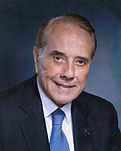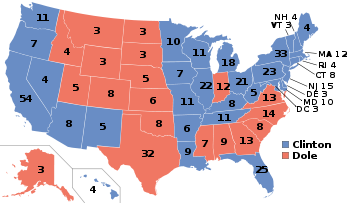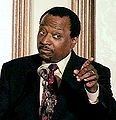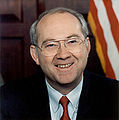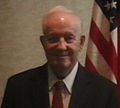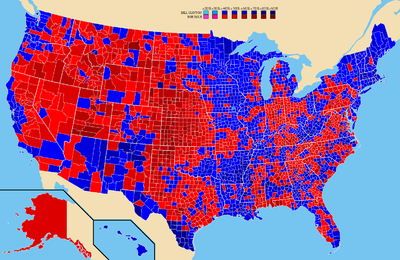- United States presidential election, 1996
-
United States presidential election, 1996 
1992 ← November 5, 1996 → 2000 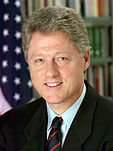

Nominee Bill Clinton Bob Dole Ross Perot Party Democratic Republican Reform Home state Arkansas Kansas Texas Running mate Al Gore Jack Kemp Patrick Choate Electoral vote 379 159 0 States carried 31 + DC 19 0 Popular vote 47,401,185 39,197,469 8,085,294 Percentage 49.2% 40.7% 8.4%
Presidential election results map. Red denotes states won by Dole/Kemp, Blue denotes those won by Clinton/Gore.
President before election
Elected President
The United States presidential election of 1996 was a contest between the Democratic national ticket of President Bill Clinton of Arkansas and Vice President Al Gore of Tennessee and the Republican national ticket of former Senator Bob Dole of Kansas for President and former Housing Secretary Jack Kemp of New York for Vice President. Businessman Ross Perot ran as candidate for the Reform Party with economist Pat Choate as his running mate; he received less media attention and was excluded from the presidential debates and, while still obtaining substantial results for a third-party candidate, by U.S. standards, did not renew his success of the 1992 election. Clinton benefited from an economy which recovered from the early 1990s recession and a relatively stable world stage. On November 5, 1996,[1] President Clinton went on to win re-election with a substantial margin in the popular vote and electoral college.
Contents
Background
In 1995, the Republican Party was riding high on the gains made in the 1994 congressional elections. In those elections, the Republicans, led by Newt Gingrich, captured the majority of seats in the United States House of Representatives for the first time in 40 years and the majority of seats in the U.S. Senate for the first time in eight years.
Nominations
Democratic Party nomination
Democratic Candidates
- Bill Clinton, President of the United States from Arkansas
- Lyndon LaRouche, of Virginia
- Pat Paulsen, comedian from California
- James D. Griffin, former Mayor of Buffalo, New York
Candidates gallery
With the advantage of incumbency, Bill Clinton's path to renomination by the Democratic Party was uneventful. At the 1996 Democratic National Convention, Clinton and incumbent Vice President Al Gore were renominated with token opposition. Incarcerated fringe candidate Lyndon LaRouche won a few Arkansas delegates who were barred from the convention. Jimmy Griffin, former Mayor of Buffalo, New York, mounted a brief campaign but withdrew after a poor showing in the New Hampshire primary. Former Pennsylvania governor Bob Casey contemplated a challenge to Clinton, but health problems forced Casey to abandon a bid.[2][3]
Clinton easily won primaries nationwide, with margins consistently higher than 80%.[4]
- Bill Clinton (inc.) - 9,706,802 (88.98%)
- Lyndon LaRouche - 596,422 (5.47%)
- Unpledged - 411,270 (3.77%)
Republican Party nomination
Republican Candidates
- Bob Dole, U.S. Senator from Kansas
- Pat Buchanan, conservative columnist from Virginia
- Steve Forbes, newspaper and magazine publisher from New York
- Lamar Alexander, former Governor of Tennessee
- Phil Gramm, U.S. Senator from Texas
- Alan Keyes, former U.S. ECOSOC Ambassador from Maryland
- Richard Lugar, U.S. Senator from Indiana
- Bob Dornan, U.S. representative from California
- Arlen Specter, U.S. Senator from Pennsylvania
- Pete Wilson, Governor of California
- Morry Taylor, businessman from Illinois
- Charles E. Collins, perennial candidate from Florida
- Isabell Masters, perennial candidate from Kansas
- Jack Fellure, perennial candidate from West Virginia
- Tennie Rogers, perennial candidate from Oklahoma
- Arthur Fletcher, government official from Washington D.C.
Candidates gallery
-
Newspaper and magazine publisher Steve Forbes of New York
-
Former Governor Lamar Alexander of Tennessee
-
Former U.S. ECOSOC Ambassador Alan Keyes of Maryland
-
Senator Richard Lugar of Indiana
-
Senator Phil Gramm of Texas
-
Representative Bob Dornan of California
-
Senator Arlen Specter of Pennsylvania
-
Jack Fellure of West Virginia
A number of Republican candidates entered the field to challenge the incumbent Democratic President, Bill Clinton.
The fragmented field of candidates debated issues such as a flat tax and other tax cut proposals, and a return to supply-side economic policies popularized by Ronald Reagan. More attention was drawn to the race by the budget stalemate in 1995 between the Congress and the President, which caused temporary shutdowns and slowdowns in many areas of federal government service.
Former U.S. Army General Colin L. Powell was widely courted as a potential Republican nominee. However, on November 8, 1995, Powell announced that he would not seek the nomination. Former Secretary of Defense and future Vice President of the United States Dick Cheney was touted by many as a possible candidate for the presidency, but he declared his intentions not to run in early 1995. Former and future Defense Secretary Donald Rumsfeld formed a presidential campaign exploratory committee, but declined to formally enter the race.
Primaries and convention
Going into the 1996 primary contest, Senate majority leader and former vice-presidential nominee Bob Dole was seen as the most likely winner. However, in the primaries and caucuses, social conservative Pat Buchanan received early victories in Alaska, Louisiana, a strong second place in the Iowa Caucus, and a surprising victory in the key New Hampshire primary, while Steve Forbes finished first in Delaware and Arizona. This put Dole's leadership in doubt. However, Dole won every primary starting with North and South Dakota, which gave him a lock on the Republican nomination. Dole resigned his Senate seat on June 11. The Republican National Convention formally nominated Dole on August 15, 1996 as the GOP candidate for the fall election.
Popular primaries vote[5]
- Bob Dole - 9,024,742 (58.82%)
- Pat Buchanan - 3,184,943 (20.76%)
- Steve Forbes - 1,751,187 (11.41%)
- Lamar Alexander - 495,590 (3.23%)
- Alan Keyes - 471,716 (3.08%)
- Richard Lugar - 127,111 (0.83%)
- Unpledged - 123,278 (0.80%)
- Phil Gramm - 71,456 (0.47%)
- Bob Dornan - 42,140 (0.28%)
- Morry Taylor - 21,180 (0.14%)
Convention tally:
- Bob Dole 1928
- Pat Buchanan 47
- Steve Forbes 2
- Alan Keyes 1
- Robert Bork 1
VP Selection
Former Congressman and Housing Secretary Jack Kemp was nominated by acclamation as Dole's running mate the following day.
Other politicians mentioned as possible GOP V.P. nominees before Kemp was selected included:
- Lamar Alexander, former Governor of Tennessee
- George Allen, Governor of Virginia
- John Ashcroft, U.S. Senator from Missouri
- David Beasley, Governor of South Carolina
- Bill Bennett, former Secretary of Education from New York
- Ken Blackwell, Ohio State Treasurer
- Pat Buchanan, conservative commentator
- George W. Bush, Governor of Texas
- Carroll Campbell, Former Governor of South Carolina
- Dick Cheney, former Secretary of Defense from Texas
- Christopher Cox, U.S. Representative from California
- Alfonse D'Amato, U.S. Senator from New York
- George Deukmejian, former Governor of California
- Tom DeLay, U.S. Representative from Texas
- Pete Domenici, U.S. Senator from New Mexico
- Jim Edgar, Governor of Illinois
- John Engler, Governor of Michigan
- Steve Forbes, publisher from New Jersey
- Phil Gramm, U.S. Senator from Texas
- Kay Bailey Hutchinson, U.S. Senator from Texas
- John Kasich, U.S. Representative from Ohio
- Alan Keyes, former Ambassador from Maryland
- Steve Largent, U.S. Representative from Oklahoma
- Dan Lungren, California Attorney General
- Dick Lugar, U.S. Senator from Indiana
- Connie Mack III, U.S. Senator from Florida
- Lynn Martin, former Labor Secretary from Illinois
- John McCain, U.S. Senator from Arizona
- David McIntosh, U.S. Representative from Indiana
- Steve Merrill, Governor of New Hampshire
- Susan Molinari, U.S. Representative from New York
- Sue Myrick, U.S. Representative from North Carolina
- Sam Nunn, U.S. Senator from Georgia
- George Pataki, Governor of New York
- Colin Powell, former Chairman of the Joint Chiefs of Staff from New York
- Tom Ridge, Governor of Pennsylvania
- Warren Rudman, former U.S. Senator from New Hampshire
- Fred Thompson, U.S. Senator from Tennessee
- Tommy Thompson, Governor of Wisconsin
- George Voinovich, Governor of Ohio
- J.C. Watts, U.S. Representative from Oklahoma
- Christine Todd Whitman, Governor of New Jersey
- Pete Wilson, Governor of California
Notable endorsements
Bob Dole
- Former Senator and 1964 Presidential nominee Barry Goldwater of Arizona[6]
- Governor George W. Bush of Texas[5]
- Senator William V. Roth of Delaware[5]
- Senator Alan K. Simpson of Wyoming[5]
- Senator Al D'Amato of New York[5]
- Former Governor Pierre S. du Pont IV of Delaware[7]
- Former Governor George Wallace of Alabama[8]
Pat Buchanan
- Governor Mike Foster of Louisiana[9]
- State Senator Dick Mountjoy of California
- Former U.S. National Security Advisor Richard V. Allen
- Former Governor Evan Mecham of Arizona[10]
- Future Congressman Trent Franks of Arizona
Steve Forbes
- Former Congressman and HUD Secretary Jack Kemp of New York[5]
- Former Senator Gordon Humphrey of New Hampshire[5]
Lamar Alexander
- Former Governor Thomas H. Kean of New Jersey[5]
- Former Secretary of Education Bill Bennett[5]
W. Phillip Gramm
- Senator John McCain of Arizona[5]
- Senator Kay Bailey Hutchinson of Texas[5]
Pete Wilson
- Governor William Weld of Massachusetts[5]
- Perot's 1992 running-mate and retired admiral James Bond Stockdale of Illinois[5]
Reform Party nomination
Two Reform candidates entered the field to challenge the incumbent Democratic President, Bill Clinton. They were:
- Richard Lamm - former Governor of Colorado
- Ross Perot - party founder, ran in 1992 election from Texas
The United States Reform Party nominated party founder Ross Perot of Texas in its first election as an official political party. Although Perot easily won the nomination, his victory at the party's national convention led to a schism, as supporters of his opponent, former Governor Richard Lamm of Colorado, accused him of rigging the vote to prevent them from casting their ballots. This faction walked out of the national convention and eventually formed their own group, the American Reform Party. Economist Pat Choate was nominated for Vice President.
Other nominations
The United States Green Party - Ralph Nader of Connecticut was drafted as a candidate for President of the United States on the Green Party ticket. He was not formally nominated by the Green Party USA, which was, at the time, the largest national Green group; instead he was nominated independently by various state Green parties (in some areas, he appeared on the ballot as an independent). Nader vowed to spend only $5,000 in his election campaign (to avoid having to file a financial statement with the FEC).
The Socialist Party USA nominated Mary Cal Hollis of Colorado and Eric Chester of Massachusetts.
The Libertarian Party nominated free-market writer and investment analyst, Harry Browne of Tennessee, and selected Jo Jorgensen of South Carolina as his running-mate.
The U.S. Taxpayers Party, now known as the Constitution Party, nominated former aide to President Ronald Reagan and Chairman of The Conservative Caucus Howard Phillips for President.
General election
Campaign
Without meaningful primary opposition, Clinton was able to focus on the general election early, while Dole was forced to move to the right and spend his campaign reserves fighting off challengers. Political adviser Dick Morris urged Clinton to raise huge sums of campaign funds via soft money for an unprecedented early TV blitz of swing states promoting Clinton's agenda and record. As a result, Clinton could run a campaign through the summer defining his opponent as an aged conservative far from the mainstream before Dole was in a position to respond. Compared to the 50-year-old Clinton, then 73-year-old Dole appeared especially old and frail, as illustrated by an embarrassing fall off a stage during a campaign event. Dole further enhanced this contrast on September 18 when he made a reference to a no-hitter thrown the day before by Hideo Nomo of the “Brooklyn Dodgers”, a team that had left Brooklyn for Los Angeles four decades earlier. A few days later Dole would make a joke about the remark saying "And I'd like to congratulate the St. Louis Cardinals on winning the N.L. Central. Notice I said the St. Louis Cardinals not the St. Louis Browns." (The Browns had left St. Louis after the 1954 season to become the Baltimore Orioles.)
With respect to the issues, Dole promised a 15% across-the-board reduction in income tax rates and made former Congressman and supply side advocate Jack Kemp his running mate. Bill Clinton framed the narrative against Dole early, painting him as a mere clone of unpopular House Speaker Newt Gingrich, warning America that Bob Dole would work in concert with the Republican Congress to slash popular social programs, like Medicare and Social Security, dubbed by Clinton as "Dole-Gingrich".[11] Bob Dole's tax-cut plan found itself under attack from the White House, who said it would "blow a hole in the deficit" which had been cut nearly in half during his opponent's term.[12]
Throughout the run-up to the general election, Clinton maintained comfortable leads in the polls over Dole and Perot. The televised debates featured only Dole and Clinton, locking out Perot and the other minor candidates from the discussion. Perot, who had been allowed to participate in the 1992 debates, would eventually take his case to court, seeking damages from not being in the debate, as well as citing unfair coverage from the major media outlets.
Campaign donations controversy
In late September 1995, questions arose regarding the Democratic National Committee's fund-raising practices. In February the following year, the People's Republic of China's alleged role in the campaign finance controversy first gained public attention after the Washington Post published a story stating that a U.S. Department of Justice investigation had discovered evidence that agents of China sought to direct contributions from foreign sources to the DNC before the 1996 presidential campaign. The paper wrote that intelligence information had showed the Chinese Embassy in Washington, D.C. was used for coordinating contributions to the DNC[13] in violation of U.S. law forbidding non-American citizens from giving monetary donations to U.S. politicians and political parties. Seventeen people were eventually convicted for fraud or for funneling Asian funds into the U.S. elections.
One of the more notable events learned involved Vice President Al Gore and a fund-raising event held at Hsi Lai Temple in Hacienda Heights, California. The Temple event was organized by DNC fund-raisers John Huang and Maria Hsia. It is illegal under U.S. law for religious organizations to donate money to politicians or political groups due to their tax-exempt status. The U.S. Justice Department alleged Hsia facilitated $100,000 in illegal contributions to the 1996 Clinton-Gore re-election campaign through her efforts at the Temple. Hsia was eventually convicted by a jury in March 2000.[14] The DNC eventually returned the money donated by the Temple's monks and nuns. Twelve nuns and employees of the Temple refused to answer questions by pleading the Fifth Amendment when they were subpoenaed to testify before Congress in 1997.[15]
Results
In the end, President Clinton won a decisive victory over Dole, becoming the first Democrat to win presidential reelection since Franklin Roosevelt. In the popular vote, he outpolled Dole by over 8.2 million votes. The Electoral College map did not change much from the previous election, with the Democratic incumbent winning 379 votes to the Republican ticket's 159. In the West, Dole managed to narrowly win Colorado and Montana (both had voted for Clinton in 1992), while Clinton became the first Democrat to win the state of Arizona since Harry Truman in 1948. In the South, Clinton took Florida-a state which he failed to win in 1992- from the Republicans in exchange for the less electoral-vote-rich Georgia. The election helped to cement Democratic Presidential prospects in states including California, Vermont, Maine, Illinois, New Jersey, Pennsylvania, Michigan, Delaware, and Connecticut; all went on to vote Democratic in subsequent Presidential elections, having voted Republican in the three prior to 1992. Those states also voted for Richard Nixon in the 1972 landslide. 1996 marked the first time since the 1944 Presidential contest that New Hampshire voted for a Democrat in two successive elections.
Reform Party nominee Ross Perot won approximately 8% of the popular vote. His vote total was less than half of his performance in 1992. The 1996 national exit poll showed that just as in 1992,[16] Reform Party nominee Ross Perot's supporters drew from Clinton and Dole equally.[17] In polls directed at Perot voters as to who would be a second choice, Clinton consistently held substantial leads.[18]
Although he hailed from Arkansas, Clinton carried just four of the eleven states of the American South, tying his 1992 run for the weakest performance by a winning Democratic presidential candidate in the region before 2000 (in terms of states won). Clinton's performance seems to have been part of a broader decline in support for the Democratic Party in the South. In the 2000 and 2004 elections, the Democrats would fail to carry even one of the Southern states, contributing to their defeat both times. This completed the Republican takeover of the American South, a region in which Democrats had held a near monopoly from 1880 to 1960. However, in 2008, the Democrats were able to win three Southern States, but that was still worse than Clinton's performances in both 1992 and 1996. This was the last election in which a third-party candidate carried over 3% of the national popular vote. Since 1984, no winning Presidential candidate has surpassed Bill Clinton's 8.5 percentage popular vote margin, or his 220 electoral vote margin since 1988. Also note that no Democratic Presidential candidate has surpassed Clinton's 8.5 percentage popular vote margin since 1940 (except 1964), and no Democratic Presidential candidate has surpassed his electoral vote margin since 1964. The election was also notable for the fact that for the first time in U.S. history the winner was elected without winning the male vote and the third time in U.S. history that a candidate was elected President twice without receiving a majority of the popular vote in either election (Grover Cleveland and Woodrow Wilson are the others).[17]
This was the last time the following states voted Democratic: Arizona, Arkansas, Tennessee, Louisiana, Kentucky, West Virginia and Missouri as of the 2008 election.
Presidential candidate Party Home state Popular vote Electoral
voteRunning mate Count Pct Vice-presidential candidate Home state Elect. vote William Jefferson Clinton Democratic(a) Arkansas 47,401,185 49.24% 379 Albert Arnold Gore, Jr. Tennessee 379 Robert Joseph Dole Republican(b) Kansas 39,197,469 40.71% 159 Jack French Kemp New York 159 Henry Ross Perot Reform(c) Texas 8,085,294 8.40% 0 Patrick Jeffrey Choate(d) District of Columbia 0 Ralph Nader Green Connecticut 684,871 0.71% 0 —(e) 0 Harry Browne Libertarian Tennessee 485,759 0.50% 0 Jo Jorgensen South Carolina 0 Howard Phillips Taxpayers Virginia 184,656 0.19% 0 Herbert Titus Oregon 0 John Hagelin Natural Law Iowa 113,670 0.12% 0 Michael Tompkins 0 Other(f) 113,667 0.12% — Other(f) — Total 96,277,634 100% 538 538 Needed to win 270 270 Official Source (Popular Vote): 1996 Official Presidential General Election Results
Source (popular and electoral vote): Federal Elections Commission Electoral and Popular Vote Summary unofficial Secondary Source (Popular Vote): Leip, David. 1996 Presidential Election Results. Dave Leip's Atlas of U.S. Presidential Elections (August 7, 2005).
Voting age population: 196,498,000
Percent of voting age population casting a vote for President: 49.00%
(a) In New York, the Clinton vote was a fusion of the Democratic and Liberal slates. There, Clinton obtained 3,649,630 votes on the Democratic ticket and 106,547 votes on the Liberal ticket.[19]
(b) In New York, the Dole vote was a fusion of the Republican, Conservative, and Freedom slates. There, Dole obtained 1,738,707 votes on the Republican ticket, 183,392 votes on the Conservative ticket, and 11,393 votes on the Freedom ticket.[19]
(c) In South Carolina, the Perot vote was a fusion of the Reform and Patriot slates. There, Perot obtained 27,464 votes on the Reform ticket and 36,913 votes on the Patriot ticket.[19]
(d) On the California, Indiana, Iowa, Kansas, Louisiana, Maine, Maryland, Missouri, Montana, Oregon, South Dakota, Tennessee, and Texas election ballots, James Campbell of California, Perot's former boss at IBM, was listed as a stand-in Vice-Presidential candidate until Perot decided on Pat Choate as his choice for Vice President.
(e) The Green Party vice presidential candidate varied from state to state, giving Nader a total of four running mates.[20] Winona LaDuke was his vice presidential candidate in nineteen of the twenty-two states where he appeared on the ballot. Anne Goeke was Nader's running mate in Iowa[21] and Pennsylvania. Madelyn Hoffman was Nader's running mate in New Jersey.[22] And Muriel Tillinghast was the running mate in New York.[23]
(f) Candidates receiving less than 0.05% of the total popular vote.Results by state
Bill Clinton
DemocraticBob Dole
RepublicanRoss Perot
ReformOthers State Total State electoral
votes# % electoral
votes# % electoral
votes# % electoral
votes# % electoral
votes# Alabama 9 662,165 43.16 - 769,044 50.12 9 92,149 6.01 - 10,991 0.72 - 1,534,349 AL Alaska 3 78,294 30.29 - 122,746 50.80 3 26,333 10.90 - 12,161 5.03 - 241,620 AK Arizona 8 653,288 46.52 8 622,073 44.29 - 112,072 7.98 - 16,972 1.21 - 1,404,405 AZ Arkansas 6 475,171 53.74 6 325,416 36.80 - 69,884 7.90 - 13,791 1.56 - 884,262 AR California 54 5,119,835 51.10 54 3,828,380 38.21 - 697,847 6.96 - 373,422 3.73 - 10,019,484 CA Colorado 8 671,152 44.33 - 691,848 45.80 8 99,629 6.59 - 48,075 3.18 - 1,510,704 CO Connecticut 8 735,740 52.83 8 483,109 34.69 - 139,523 10.02 - 34,242 2.46 - 1,392,614 CT Delaware 3 140,355 51.80 3 99,062 36.58 - 28,719 10.60 - 2,709 1 - 270,845 DE D.C. 3 158,220 85.19 3 17,339 9.34 - 3,611 1.94 - 6,556 3.53 - 185,726 DC Florida 25 2,546,870 48.02 25 2,244,536 42.32 - 483,870 9.12 - 28,518 0.54 - 5,303,794 FL Georgia 13 1,053,849 45.84 - 1,080,843 47.01 13 146,337 6.37 - 18,042 0.78 - 2,299,071 GA Hawaii 4 205,012 56.93 4 113,943 31.64 - 27,358 7.60 - 13,807 3.83 - 360,120 HI Idaho 4 165,443 33.65 - 256,595 52.18 4 62,518 12.71 - 7,163 1.46 - 491,719 ID Illinois 22 2,341,744 54.32 22 1,587,021 36.81 - 840,515 8.03 - 36,218 0.84 - 4,311,391 IL Indiana 12 887,424 41.55 - 1,006,693 47.13 12 224,299 10.50 - 17,426 0.82 - 2,135,842 IN Iowa 7 620,258 50.26 7 492,644 39.92 - 105,159 8.52 - 16,014 1.30 - 1,234,075 IA Kansas 6 387,659 36.08 - 583,245 54.29 6 92,639 8.62 - 10,757 1 - 1,074,300 KS Kentucky 8 636,614 45.84 8 623,283 44.88 - 120,396 8.67 - 8,415 0.61 - 1,388,708 KY Louisiana 9 927,837 52.01 9 712,586 39.94 - 211,478 11.81 - 123,293 6.91 - 1,783,959 LA Maine 4 312,788 51.62 4 186,378 30.76 - 85,970 14.19 - 20,761 3.43 - 605,897 ME Maryland 10 966,207 54.25 10 681,530 38.27 - 115,812 6.50 - 17,321 0.97 - 1,780,870 MD Massachusetts 12 1,571,763 61.47 12 718,107 28.09 - 227,217 8.89 - 39,698 1.55 - 2,556,785 MA Michigan 18 1,989,653 51.69 18 1,481,212 38.48 - 336,670 8.75 - 41,309 1.07 - 3,848,844 MI Minnesota 10 1,120,438 51.10 10 766,476 34.96 - 257,704 11.75 - 48,022 2.19 - 2,192,640 MN Mississippi 7 394,022 44.08 - 439,838 49.21 7 52,222 5.84 - 7,775 0.87 - 893,857 MS Missouri 11 1,025,935 47.54 11 890,016 41.24 - 217,188 10.06 - 24,926 1.16 - 2,158,065 MO Montana 3 167,922 41.23 - 179,652 44.11 3 55,229 13.56 - 4,458 1.09 - 410,583 MT Nebraska 5 236,761 34.95 - 363,467 53.65 5 71,278 10.52 - 5,909 0.87 - 677,415 NE Nevada 4 203,974 43.93 4 199,244 42.91 - 43,986 9.47 - 17,075 3.68 - 464,279 NV New Hampshire 4 246,214 49.32 4 196,532 39.37 - 48,390 9.69 - 8,039 1.61 - 499,175 NH New Jersey 15 1,652,329 53.72 15 1,103,078 35.86 - 262,134 8.52 - 58,266 1.89 - 3,075,807 NJ New Mexico 5 273,495 49.18 5 232,751 41.86 - 32,257 5.80 - 17,571 3.16 - 556,074 NM New York 33 3,756,177 59.47 33 1,933,492 30.61 - 503,458 7.97 - 123,002 1.95 - 6,316,129 NY North Carolina 14 1,107,849 44.04 - 1,225,938 48.73 14 168,059 6.68 - 13,961 0.55 - 2,515,807 NC North Dakota 3 106,905 40.13 - 125,050 46.94 3 32,515 12.20 - 1,941 0.73 - 266,411 ND Ohio 21 2,148,222 47.38 21 1,859,883 41.02 - 483,207 10.66 - 43,122 0.95 - 4,534,434 OH Oklahoma 8 488,105 40.45 - 582,315 48.26 8 130,788 10.84 - 5,505 0.46 - 1,206,713 OK Oregon 7 649,641 47.15 7 538,152 39.06 - 121,221 8.80 - 68,746 4.99 - 1,377,760 OR Pennsylvania 23 2,215,819 49.17 23 1,801,169 39.97 - 430,984 9.56 - 58,146 1.29 - 4,506,118 PA Rhode Island 4 233,050 59.71 4 104,683 26.82 - 43,723 11.20 - 8,828 2.26 - 390,284 RI South Carolina 8 504,051 43.85 - 573,458 49.89 8 64,386 5.60 - 7,562 0.66 - 1,149,457 SC South Dakota 3 139,333 43.03 - 150,543 46.49 3 31,250 9.65 - 2,700 0.83 - 323,826 SD Tennessee 11 909,146 48 11 863,530 45.59 - 105,918 5.59 - 15,511 0.82 - 1,894,105 TN Texas 32 2,459,683 43.83 - 2,736,167 48.76 - 378,537 6.75 - 37,257 0.66 - 5,611,644 TX Utah 5 221,633 33.30 - 361,911 54.37 5 66,461 9.98 - 15,624 2.35 - 665,629 UT Vermont 3 137,894 53.35 3 80,352 31.09 - 31,024 12 - 9,179 3.55 - 258,449 VT Virginia 13 1,091,060 45.15 - 1,138,350 47.10 13 159,861 6.62 - 27,371 1.13 - 2,416,642 VA Washington 11 1,123,323 49.84 11 840,712 37.30 - 201,003 8.92 - 88,799 3.94 - 2,253,837 WA West Virginia 5 327,812 51.51 5 233,946 36.76 - 71,639 11.26 - 3,062 0.48 - 636,459 WV Wisconsin 11 1,071,971 48.81 11 845,029 38.48 - 227,339 10.35 - 51,830 2.36 - 2,196,169 WI Wyoming 3 77,934 36.84 - 105,388 49.81 3 25,928 12.25 - 2,321 1.10 - 211,571 WY TOTALS: 538 47,401,185 49.24 379 39,197,469 40.71 159 8,085,294 8.40 - 1,591,119 1.65 - 96,275,401 Close states
States where margin of victory < 5%
- Kentucky, 0.96%
- Nevada, 1.02%
- Georgia, 1.17%
- Colorado, 1.37%
- Virginia, 1.96%
- Arizona, 2.22%
- Tennessee, 2.41%
- Montana, 2.88%
- South Dakota, 3.46%
- North Carolina, 4.69%
- Texas, 4.93%
States where margin of victory > 5% but < 10
- Mississippi, 5.13%
- Indiana, 5.58%
- Florida, 5.70%
- South Carolina, 6.04%
- Missouri, 6.30%
- Ohio, 6.36%
- North Dakota, 6.81%
- Alabama, 6.96%
- New Mexico, 7.32%
- Oklahoma, 7.81%
- Oregon, 8.09%
- Pennsylvania, 9.20%
- New Hampshire, 9.95%
Source: David Leip's Atlas of U.S. Presidential Elections- County Data
Voter demographics
The Presidential vote in social groups (percentages) Social group Clinton Dole Perot % of
total voteTotal vote 49 41 8 100 Party and ideology Liberal Republicans 44 48 9 2 Moderate Republicans 20 72 7 13 Conservative Republicans 6 88 5 21 Liberal independents 58 15 18 4 Moderate independents 50 30 17 15 Conservative independents 19 60 19 7 Liberal Democrats 89 5 4 13 Moderate Democrats 84 10 5 20 Conservative Democrats 69 23 7 6 Gender and marital status Married men 40 48 10 33 Married women 63 28 7 33 Unmarried men 49 35 12 15 Unmarried women 62 28 7 20 Race White 43 46 9 83 Black 84 12 4 10 Hispanic 72 21 6 5 Asian 43 48 8 1 Religion White Protestant 36 53 10 46 Catholic 53 37 9 29 Jewish 78 16 3 3 Born again/religious right 26 65 8 17 Age 18–29 years old 53 34 10 17 30–44 years old 48 41 9 33 45–59 years old 48 41 9 26 60 and older 48 44 7 24 Education Not a high school graduate 59 28 11 6 High school graduate 51 35 13 24 Some college education 48 40 10 27 College graduate 44 46 8 26 Postgraduate education 52 40 5 17 Family income Under $15,000 59 28 11 11 $15,000–$29,999 53 36 9 23 $30,000–$49,999 48 40 10 27 Over $50,000 44 48 7 39 Over $75,000 41 51 7 18 Over $100,000 38 54 6 9 Region East 55 34 9 23 Midwest 48 41 10 26 South 46 46 7 30 West 48 40 8 20 Community size Population over 500,000 68 25 6 10 Population 50,000 to 500,000 50 39 8 21 Suburbs 47 42 8 39 Rural areas, towns 45 44 10 30 Source: Voter News Service exit poll, reported in The New York Times, November 10, 1996, 28.
Polling controversy
Some post-election debate focused on the alleged flaws in the pre-election polls, almost all of which overstated Clinton's lead over Dole, some by a substantial margin. For example, a CBS/New York Times poll overstated Clinton's lead by 10 points despite having an error margin of 2.4%. The odds against this sort of error occurring were 15,000:1.[25] A less extreme example was a Pew poll which overstated Clinton's lead by 5 points, the chances of this happening were 10:1 against.[25] Gerald Wasserman, having examined eight pre-election polls, argued that pure chance would produce such a skewed result in favor of Clinton only once in 4,900 elections.[26] However, because Clinton won the election by a comfortable margain,[27] there was no major reaction towards the inaccuracy of the polls.[27] The polls were also less inaccurate than the overwhelming majority of those taken in 1948,[27] which predicted that losing candidate Thomas Dewey would beat President Harry Truman by a comfortable margain,[27] and in 1980, which predicted that Reagan would win without a landslide victory.[27]
References
- ^ "Election Dates". Uselectionatlas.org. http://uselectionatlas.org/INFORMATION/INFORMATION/dates.php. Retrieved 2010-06-17.
- ^ "Anyone left? The search for a Clinton challenger in 1996.". The Progressive. TheFreeLibrary.com. May 1, 1995. http://www.thefreelibrary.com/Anyone+left%3F+The+search+for+a+Clinton+challenger+in+1996.-a016914424. Retrieved December 6, 2010.
- ^ Newton-Small, Jay (November 24, 2009). "Can a Pro-Life Dem Bridge the Health-Care Divide?". Time. http://www.time.com/time/politics/article/0,8599,1942614,00.html. Retrieved December 6, 2010.
- ^ "US President - D Primaries Race - Feb 01, 1996". Our Campaigns. http://www.ourcampaigns.com/RaceDetail.html?RaceID=55214. Retrieved 2010-06-17.
- ^ a b c d e f g h i j k l m "US President – R Primaries Race – July 7, 1996". Our Campaigns.com. http://www.ourcampaigns.com/RaceDetail.html?RaceID=13494. Retrieved 2008-03-10.
- ^ "AZ US President - R Primary Race - Feb 27, 1996". Our Campaigns. http://www.ourcampaigns.com/RaceDetail.html?RaceID=36285. Retrieved 2010-06-17.
- ^ "DE US President - R Primary Race - Feb 24, 1996". Our Campaigns. http://www.ourcampaigns.com/RaceDetail.html?RaceID=36304. Retrieved 2010-06-17.
- ^ "Candidate - George Corley Wallace". Our Campaigns. http://www.ourcampaigns.com/CandidateDetail.html?CandidateID=4038. Retrieved 2010-06-17.
- ^ "LA US President - R Primary Race - Mar 12, 1996". Our Campaigns. http://www.ourcampaigns.com/RaceDetail.html?RaceID=36320. Retrieved 2010-06-17.
- ^ "Dole wins both Dakotas, but is lagging in Arizona." Toledo Blade. February 28, 1996. Accessed December 2, 2009. Final paragraph: Mr. Mecham is supporting Buchanan "all the way," and he still has an effective organization in the state.
- ^ Berke, Richard L. (October 7, 1996). "Clinton And Dole, Face To Face, Spar Over Medicare And Taxes". The New York Times. http://query.nytimes.com/gst/fullpage.html?res=9507E2DC1F3FF934A35753C1A960958260. Retrieved May 26, 2010.
- ^ "09/02/96 MEDICARE, TAXES, AND BOB DOLE: A TALK WITH THE PRESIDENT". Businessweek.com. 1997-06-14. http://www.businessweek.com/1996/36/b34915.htm. Retrieved 2010-06-17.
- ^ Woodward, Bob and Duffy, Brian, "Chinese Embassy Role In Contributions Probed", Washington Post, February 13, 1997
- ^ Eskenazi, Michael, "For both Gore and GOP, a guilty verdict to watch", CNN.com, March 3, 2000
- ^ Abse, Nathan, "A Look at the 94 Who Aren't Talking", Washington Post, June 9, 1998
- ^ Holmes, Steven A. (November 5, 1992). "THE 1992 ELECTIONS: DISAPPOINTMENT -- NEWS ANALYSIS An Eccentric but No Joke; Perot's Strong Showing Raises Questions On What Might Have Been, and Might Be". The New York Times. http://query.nytimes.com/gst/fullpage.html?res=9E0CE0DB1F3FF936A35752C1A964958260. Retrieved May 26, 2010.
- ^ a b Presidential Election Exit Poll http://www.cnn.com/ALLPOLITICS/1996/elections/natl.exit.poll/index1.html
- ^ 1996 Election Tracking Polls http://www.cnn.com/ALLPOLITICS/1996/polls/cnn.usa.gallup/tracking/
- ^ a b c "'96 Presidential and Congressional Election Statistics". Official website of the Office of the Clerk of the House of Representatives. Archived from the original on January 26, 2006. http://web.archive.org/web/20060126213548/http://clerk.house.gov/members/electionInfo/1996/96Stat.htm. Retrieved February 17, 2006.
- ^ Pollitt, Katha; readers of The Nation (April 10, 2000). "Saint Ralph and the Dragon". The Nation. http://www.thenation.com/doc/20000410/exchange.[dead link]
- ^ "November 12, 1996" (PDF). Minutes of the Meetings of the Board of Supervisors. Cerro Gordo County. 1996. http://www.co.cerro-gordo.ia.us/1996Minutes/November%2012,%201996.pdf. Retrieved March 30, 2006.
- ^ Fernandez, Sonia (2000-02-22). "Nader '55 to run for president". The Daily Princetonian (Daily Princetonian Publishing Company, Inc). http://www.dailyprincetonian.com/archives/2000/02/22/news/234.shtml. Retrieved 2006-03-30.
- ^ "Electors of President and Vice President". Cattaraugus County: Board of Elections: 1996 Election Results. Cattaraugus County, New York State. http://www.co.cattaraugus.ny.us/election_board/past-elections/1996/presandvp.html. Retrieved March 30, 2006.
- ^ http://uselectionatlas.org/RESULTS/data.php?year=1996&datatype=national&def=1&f=0&off=0&elect=0
- ^ a b "Polls". .psych.purdue.edu. http://www2.psych.purdue.edu/~codelab/PollOdds.Table.html. Retrieved 2010-06-17.
- ^ "Were The Polls Right?". .psych.purdue.edu. http://www2.psych.purdue.edu/~codelab/PollOdds.html. Retrieved 2010-06-17.
- ^ a b c d e http://www.jstor.org/pss/2749624
Further reading
Books
- Laurence W. Moreland and Robert P. Steed, eds., ed (1997). The 1996 Presidential Election in the South: Southern Party Systems in the 1990s. ISBN 0275959511.
- Ceaser, James W.; Andrew E. Busch (1997). Losing to Win: The 1996 Elections and American Politics. ISBN 0847684059.
- Clinton, Bill (2005). My Life. Vintage. ISBN 1-4000-3003-X.
- Green, John C. (1999). Financing the 1996 Election. ISBN 0585260141.
- Pomper, Gerald M.; et al. (1997). The Election of 1996: Reports and Interpretations. ISBN 0585224579.
Journals
- Jelen, Ted G.; Marthe Chandler (2000). "Culture Wars in the Trenches: Social Issues as Short-Term Forces in Presidential Elections, 1968–1996". The American Review of Politics 21: 69–87.
Web references
- "Libertarian Party Historical Overview". http://www.lp.org/organization/history.shtml. Retrieved January 25, 2006.
External links
- The Election Wall's 1996 Election Video Page
- 1996 popular vote by counties
- 1996 popular vote by states
- 1996 popular vote by states (with bar graphs)
- CNN: 1996 Presidential Campaign Ads
- Popular vote data from the Federal Election Commission
- How close was the 1996 election? — Michael Sheppard, Massachusetts Institute of Technology
(1994 ←) 1996 United States elections (→ 1998) President United States presidential election, 1996U.S. Senate Alabama • Alaska • Arkansas • Colorado • Delaware • Georgia • Idaho • Illinois • Iowa • Kansas • Kansas (Special) • Kentucky • Louisiana • Maine • Massachusetts • Michigan • Minnesota • Mississippi • Montana • Nebraska • New Hampshire • New Jersey • New Mexico • North Carolina • Oklahoma • Oregon • Oregon (Special) • Rhode Island • South Carolina • South Dakota • Tennessee • Texas • Virginia • West Virginia • Wyoming
U.S. House Alabama • Alaska • American Samoa • Arizona • Arkansas • California • Colorado • Connecticut • Delaware • District of Columbia • Florida • Georgia • Guam • Hawaii • Idaho • Illinois • Indiana • Iowa • Kansas • Kentucky • Louisiana • Maine • Maryland • Massachusetts • Michigan • Minnesota • Mississippi • Missouri • Montana • Nebraska • Nevada • New Hampshire • New Jersey • New Mexico • New York • North Carolina • North Dakota • Northern Mariana Islands • Ohio • Oklahoma • Oregon • Pennsylvania • Puerto Rico • Rhode Island • South Carolina • South Dakota • Tennessee • Texas • Utah • Vermont • Virginia • United States Virgin Islands • Washington • West Virginia • Wisconsin • Wyoming
Governors American Samoa • Delaware • Indiana • Missouri • Montana • New Hampshire • North Carolina • North Dakota • Puerto Rico • Utah • Vermont • Washington • West Virginia
States Alabama • Alaska • American Samoa • Arizona • Arkansas • California • Colorado • Connecticut • Delaware • Florida • Georgia • Guam • Hawaii • Idaho • Illinois • Indiana • Iowa • Kansas • Kentucky • Louisiana • Maine • Maryland • Massachusetts • Michigan • Minnesota • Mississippi • Missouri • Montana • Nebraska • Nevada • New Hampshire • New Jersey • New Mexico • New York • North Carolina • North Dakota • Ohio • Oklahoma • Oregon • Pennsylvania • Puerto Rico • Rhode Island • South Carolina • South Dakota • Tennessee • Texas • United States Virgin Islands • Utah • Vermont • Virginia • Washington • West Virginia • Wisconsin • Wyoming
United States presidential election, 1996 Democratic Party
Convention • PrimariesNominee: Bill Clinton
VP nominee: Al Gore
Candidates: James D. Griffin • Lyndon La Rouche (campaign) • Pat PaulsenRepublican Party
Convention • PrimariesNominee: Bob Dole
VP nominee: Jack Kemp
Candidates: Lamar Alexander • Pat Buchanan • Charles E. Collins • Bob Dornan • Jack Fellure • Arthur Fletcher • Steve Forbes • Phil Gramm • Alan Keyes • Richard Lugar • Isabell Masters • Jimmy McMillan • Tennie Rogers • Arlen Specter • Morry Taylor • Pete WilsonReform Party Other Third party and independent candidates Green Party
ConventionLibertarian Party
ConventionNatural Law Party Prohibition Party Socialist Party USA Socialist Workers Party U.S. Taxpayers Party Workers World Party Independents and other candidates  United States presidential elections
United States presidential elections1788 · 1792 · 1796 · 1800 · 1804 · 1808 · 1812 · 1816 · 1820 · 1824 · 1828 · 1832 · 1836 · 1840 · 1844 · 1848 · 1852 · 1856 · 1860 · 1864 · 1868 · 1872 · 1876 · 1880 · 1884 · 1888 · 1892 · 1896 · 1900 · 1904 · 1908 · 1912 · 1916 · 1920 · 1924 · 1928 · 1932 · 1936 · 1940 · 1944 · 1948 · 1952 · 1956 · 1960 · 1964 · 1968 · 1972 · 1976 · 1980 · 1984 · 1988 · 1992 · 1996 · 2000 · 2004 · 2008 · 2012
Electoral College · Electoral vote changes · Electoral votes by state · Results by Electoral College margin · Results by popular vote margin · Results by state · Voter turnout · Presidential primaries · Presidential nominating conventionsSee also: House elections · Senate elections · Gubernatorial electionsNotable third party performances in United States elections (At least 5% of the vote) Presidential (Since 1832) Senatorial (Since 1990) Virginia 1990 · Alaska 1992 · Arizona 1992 · Hawaii 1992 · Ohio 1992 · Arizona 1994 · Minnesota 1994 · Ohio 1994 · Vermont 1994 · Virginia 1994 · Alaska 1996 · Minnesota 1996 · Arizona 2000 · Massachusetts 2000 · Minnesota 2000 · Alaska 2002 · Kansas 2002 · Massachusetts 2002 · Mississippi 2002 · Oklahoma 2002 · Virginia 2002 · Oklahoma 2004 · Connecticut 2006 · Indiana 2006 · Maine 2006 · Vermont 2006 · Arkansas 2008 · Minnesota 2008 · Oregon 2008 · Florida 2010 · Indiana 2010 · South Carolina 2010 · Utah 2010Gubernatorial (Since 1990) Alaska 1990 · Connecticut 1990 · Kansas 1990 · Maine 1990 · New York 1990 · Oklahoma 1990 · Oregon 1990 · Utah 1992 · West Virginia 1992 · Alaska 1994 · Connecticut 1994 · Hawaii 1994 · Maine 1994 · New Mexico 1994 · Oklahoma 1994 · Pennsylvania 1994 · Rhode Island 1994 · Vermont 1994 · Alaska 1998 · Maine 1998 · Minnesota 1998 · New York 1998 · Pennsylvania 1998 · Rhode Island 1998 · Kentucky 1999 · New Hampshire 2000 · Vermont 2000 · Arizona 2002 · California 2002 · Maine 2002 · Minnesota 2002 · New Mexico 2002 · New York 2002 · Oklahoma 2002 · Wisconsin 2002 · Alaska 2006 · Illinois 2006 · Maine 2006 · Massachusetts 2006 · Minnesota 2006 · Texas 2006 · Louisiana 2007 · Vermont 2008 · New Jersey 2009 · Colorado 2010 · Idaho 2010 · Maine 2010 · Massachusetts 2010 · Minnesota 2010 · Rhode Island 2010 · Wyoming 2010Portal:Politics - Third party (United States) - Third party officeholders in the United States - Third party United States House of Representatives
Wikimedia Foundation. 2010.

